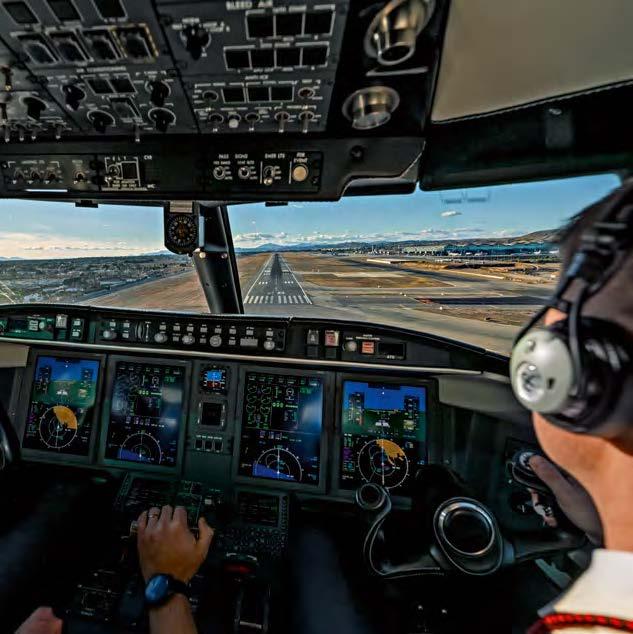
Two holidays come to an abrupt end
Combined repatriation after a riding and a motor bike accident.
Page 26 Reader survey Take part now and win attractive prizes! See back page for more information The
Issue no. 102 06.2024
Rega magazine

Rega magazine 1414, issue no. 102, June 2024 Published by: Swiss Air-Rescue Rega, PO Box 1414, CH-8058 Zurich Airport, rega.ch Foundation Board & Management Board: rega.ch/organisation
team:
Müller
Zahner
Photos: Tom Lüthi (1, 2, 5, 15, 17, 26 – 29), Adrian Bretscher (11, 30), Daniel Hegglin (4), Corina Zellweger (4), Karin Zahner (6 – 10), Mathias Gehrig (18, 21, 23 – 25), Remo Nägeli (18 – 19), Karin Hörhager (19), Petra Imhof (21) Contents Publication information Reprints permitted with sources indicated. News Latest news and interesting facts from the world of Rega 4 At home Work accident, evacuation, illness: a day at the Rega base in Zweisimmen 6 Opinion by Ernst Kohler, CEO of Rega 11 Outlook In constant contact with the crew thanks to cutting-edge technology 12 RegaCLUB magazine For the youngest Rega fans 15 24h Rega Sarah Freiburghaus, intensive care flight nurse on board the ambulance jet 23 Abroad When horsepower runs wild and the holiday ends up in hospital 26 Dialogue Daniel Landert, Head of Jet Operations, on how Rega helps abroad 30 Knowledge How to react in the event of swimming accidents in open water 32 Marketplace Popular products in the Rega Shop 34 Concept/Design/Prepress: Source Associates AG Production: tutto fatto Print: Swissprinters Total circulation: 1.9 million Published: twice a year 2
Editorial
David
(Editor-in-Chief), Karin
(Managing Editor), Maria Betschart, Larissa Fabig, Mathias Gehrig, Federica Mauri, Adrian Schindler, Ron Sinoimeri, David Suchet, Jérôme Zaugg, Corina Zellweger
“During the summer holidays, too, Rega is always there for you in an emergency.”
 David Müller Editor-in-Chief
David Müller Editor-in-Chief
The summer holidays are rapidly approaching. We look forward to a carefree vacation – whether on a beautiful beach, visiting relatives or friends, at the local swimming pool or hiking in the Swiss mountains.
Unfortunately, even on holiday, nobody is immune to accident or illness. However, if something does happen, Rega is there for you. You can count on us in an emergency! Give us a call – either via the emergency number 1414 within Switzerland or on +41 333 333 333 (nine times three) from abroad.
Did you know that you can also call on Rega if you suffer a medical problem abroad? Well, you can – and that is another good reason for being a Rega patron. No matter where in the world you happen to be, you can contact our medical consultants at any time. They will provide you with competent medical advice around the clock. And if repatriation is necessary, as a patron you do not have to worry about transport arrangements or the ensuing costs. For Rega will either accompany you home on a scheduled flight or fly you back to Switzerland in one of our three ambulance jets. What’s more, Rega can waive any of its mission costs that are not covered by your insurance policy. In short: with Rega patronage, you are optimally prepared in the event of an emergency.
I wish you a happy and healthy summer holiday!
Editorial
3
Takeoff

Four Rega helicopters for New Zealand
Rega is selling four Airbus Helicopters H145 rescue helicopters, including their medical equipment, to the New Zealand air rescue organisation, GCH Aviation. Thus the helicopters will continue to be deployed to help people in distress. The sale is part of Rega’s measures to modernise its helicopter fleet by the end of 2026: in future, Rega will rely on a single-type fleet of 21 H145 rescue helicopters in the latest five-bladed version from manufacturer Airbus Helicopters. Consequently, the same type of helicopter will be in operation at all its bases. This will simplify maintenance and result in savings in the procurement and management of spare parts. It also means less time and money spent on training the crews, and synergies can be utilised even more effectively. By investing in the new fleet, Rega is ensuring that it can continue to provide patients with reliable and professional medical assistance by air for the next 15 years.
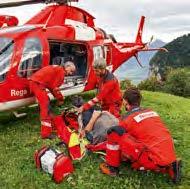
37 patients per day: Rega’s help is also in great demand in 2023
The services of Swiss Air-Rescue Rega were once again frequently in demand in 2023. The Operations Center organised a total of 20,647 missions. On average, the Rega crews came to the aid of 37 patients per day. Both the rescue helicopters and the ambulance jets were in the air almost as frequently as in the record year 2022. The mission numbers for last year were 15.7 percent higher than the five-year average and correspond to the second highest in Rega’s history.
3 Further information: report.rega.ch
News Visit us online rega.ch regaclub.ch Rega on social media rega_offiziell rega1414 regatvEN 4

Have you already paid your patronage contribution?
Has there been a new addition to your family and you want to register your child for free? Would you like to notify us of a change of address or check if you have paid your patronage contribution? You can do all this quickly and easily online via our patron portal. Here you can manage and update your personal details yourself at any time.
3 Register at rega.ch/login
The Rega helicopters
Typhoon 15 daypack

The Typhoon 15 backpack from Exped is waterproof, lightweight and compact. It is the ideal companion for short hikes, bike tours or a stroll through the city. Dimensions: 42 × 20 × 15 cm, CHF 99.–.
3 Order now: from page 34 or at rega.ch/shop
Free patronage for children and young people
Did you know? Rega patronage is free of charge for children and young people under the age of 18. To enable your child, godchild or grandchild to benefit from Rega patronage, you can simply register them online. Children under 12 years automatically become members of the RegaCLUB.
3 Register now: rega.ch/patrons 20

12,321
Are you familiar with the Rega newsletter?
Every two months, our newsletter informs you by e-mail about the latest news from Rega. You can look forward to fascinating videos, interesting background information, as well as prize draws and competitions.
3 Subscribe now: rega.ch/newsletter
helicopter bases are spread across the country in such a way that the crews can reach any location in Switzerland within 15 flight minutes.
rescue helicopters bring medical assistance by air. 14
patients
the
2023.
were transported by
Rega helicopters in
5

A day with Rega
14
6

The sunny Saturday brings the Rega crew from the helicopter base in Zweisimmen five missions that demonstrate the diversity of Rega’s scope of operations: two acute illnesses, an accident at work, a sports accident and an evacuation.
7 am: The sun is on the horizon as the Rega 14 crew begin their working day at the Zweisimmen helicopter base. The sky is blue and the gentle tinkling of cowbells filters in from outside. The kitchen table is set with bread, cheese, butter and honey. Seated around it are the crew for the day: pilot Adrian von Siebenthal, paramedic Peter Lempen and emergency flight physician Jacqueline Leitl. Von Siebenthal starts with the morning briefing: “The weather is good, the air pressure is evenly distributed. The helicopter has come straight from maintenance. We’ve inspected the rescue hoist.” Peter Lempen nods and adds: “The ventilator, the oxygen cylinders and the monitoring device – they’ve all been checked.” “And the emergency backpack is ready,” says Jacqueline Leitl. Even before she finishes the sentence, their smartphones start beeping: an emergency. The crew members put down their coffee cups and head quickly but calmly to the hangar and to the rescue helicopter, which
Mission at home
7
After the patient has received first aid, the helpers and the Rega crew carry her to the helicopter.
takes off just a few minutes later. A mountain farmer has raised the alarm: he thinks he may have deep vein thrombosis in his leg. After a short flight, Adrian von Siebenthal sets down the helicopter on the meadow near the mountain hut. Jacqueline Leitl examines the patient and gives the all clear: it is not thrombosis, but probably a trapped nerve. The man is flown to Zweisimmen Hospital and subsequently Rega 14 returns to the base.
Overturned hay loader
1142
– that is how many times the Rega crews were called out in 2023 following accidents at work.
Around 20 minutes later, just before 11 am, the next alarm call sounds again. A farmer has had a serious accident near Linter, a hamlet near Frutigen: his transporter with a hay loader has overturned. The crew prepare themselves mentally for a challenging mission. According to the alarm report, the man has suffered serious injuries. He has an open traumatic brain injury and is unconscious. During the flight, only the radio and the noise of the rotor blades can be heard in the cabin. On arriving at the accident scene, with the helicopter skids lightly touching the ground and the rotor blades still turning, the pilot allows the paramedic and emergency flight physician to alight and shortly afterwards lands on the narrow mountain road. The casualty is Samuel Schmid and relatives have already been able to free him from the vehicle. The patient is in a bad state. A large contused laceration on his head is bleeding profusely. He also has severe pain in the area around his cervical spine. However, in the meantime, Samuel Schmid is responsive again. For the first time, the medical crew from Rega 14 can breathe a short sigh of relief. Peter Lempen and Jacqueline Leitl work hand in hand to care for the man: they apply a dressing, monitor his breathing and circulation, and examine him

for other injuries and neurological disorders, but fortunately find nothing of concern. They inject Samuel Schmid with a haemostatic and a pain-relieving drug and put a cervical collar on him. Afterwards, they carefully lift the patient onto a vacuum mattress, carry him to the helicopter and load him into the cabin.
Short flight to the Inselspital
While Rega 14 takes off, flies around the Niesen mountain and follows the River Aare towards the Inselspital, the Rega Operations Center at Zurich Airport takes care of all the registration formalities for the patient at the hospital. The route from Frutigen to Bern is quickly covered by the helicopter. Barely 20 minutes later, the helicopter lands on the roof of the Inselspital. The crew take Samuel Schmid to the shock room and hand him over to the medical specialists, who are now responsible for his care. The farewell is brief: “Bye everyone, take care!” Rega 14 takes off and flies back to the base. In the cabin, Jacqueline Leitl is relieved: “Fortunately his condition didn’t get worse.
8
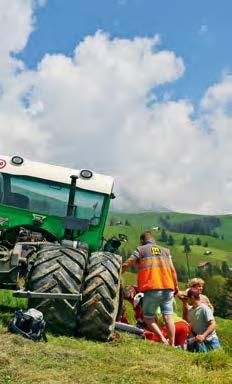

Things could have turned out very differently.”
Evacuation with the rescue hoist
No sooner has the helicopter landed than the next alarm call comes in at 12.30 pm. A young man has taken a tumble at the Wiriehorn bike park and broken his collarbone. It is not possible to land directly next to the patient, so Jacqueline Leitl and Peter Lempen exit the helicopter while it is hovering just above the ground and Adrian von Siebenthal then lands the Da Vinci a short distance away. The biker describes how the accident happened. “I tried to ride around a fence gate because I didn’t want to scratch my new bike. Unfortunately, that idea misfired,” he says ruefully. Jacqueline Leitl administers a painkiller and takes him to the helicopter. The young man is flown to Thun Hospital, after which the crew return to the base. There, everyone goes about their duties once more: the paramedic refuels the helicopter, the emergency physician replenishes the medical supplies, and the pilot records the details of the mission on the computer. Then it
is time for lunch: sausage and salad.
At 3.55 pm, the alarm b eeps again. Fog and a belt of snow near the Tschentenalp make it impossible for a couple to ascend or descend. Adrian von Siebenthal checks the location on the map. “The terrain is very steep,” he says. “Evacuation will be difficult, so we’ll need to take a rescue specialist with us.” He informs the Operations Center. After a few minutes, the flight coordinator radios in: “You can pick up Franz Baumgartner”. Rega 14 flies to the home of the helicopter rescue specialist from the Swiss Alpine Club SAC and he climbs aboard. The helicopter continues on its way to the stranded couple in the mountains. As it is impossible to land directly next to them, Adrian von Siebenthal looks for a temporary landing site nearby, where emergency flight physician Jacqueline Leitl disembarks. The pilot, paramedic and helicopter rescue specialist remain in the helicopter and subsequently evacuate one per-
627
people were evacuated by the Rega crews in 2023.
Left: After a serious accident while working, the Rega crew attend to farmer Samuel Schmid.
Right: Emergency flight physician Jacqueline Leitl monitors his condition during the flight to hospital.
9
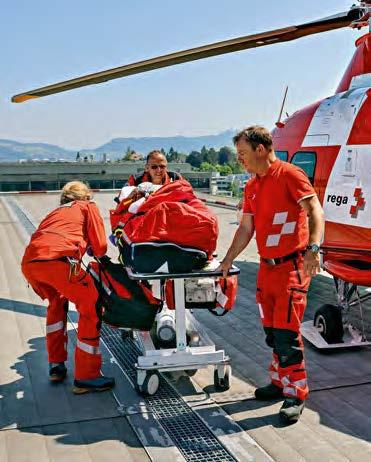


son after the other on the rescue hoist. They are set down beside the emergency flight physician with pinpoint accuracy. As both are uninjured, they are able to make their way back down into the valley on their own.
The Rega rescue helicopters are most frequently called out on missions due to illness.
Stroke in a remote farmhouse
Another alarm comes in at 5.16 pm. The suspected cause is “cerebral vascular accident”, which could mean a stroke. Rega 14 flies in the direction of Tschuggen, in the Diemtigtal valley. The landscape is beautiful: a single “Heimetli” – an old, remotely located farmhouse – lies surrounded by meadows. But there is no time to enjoy the scenery. As soon as the helicopter lands, Jacqueline Leitl and Peter Lempen head
for the house. Veronika Mast is sitting on the balcony floor, leaning against the railing. Her husband relates: “My wife was sitting reading when she suddenly felt nauseous and dizzy. She has the feeling that one side of her face is numb.” The emergency flight physician asks Veronika Mast to blow out her cheeks. Both cheeks puff out – and there are no other signs of neurological deficiency either. Jacqueline Leitl gives the woman medication for nausea, then the patient is carried to the helicopter on a stretcher and flown to the Inselspital in Bern for a check-up. Back at the base, Jacqueline Leitl refills the medical materials once more, Peter Lempen refuels the rescue helicopter, and Adrian von Siebenthal writes up the mission – the last one of the day.
Karin Zahner
Left: Landing on the helipad at the Inselspital. Top right: The crew take the patient into the hospital. Bottom right: Emergency flight physician Jacqueline Leitl replenishes the emergency backpack with medical supplies.
10
“Rega is much more than mountain rescue.”
Ernst Kohler 61, CEO of Rega

“I no longer ski – so I don’t need Rega patronage anymore.” I hear this sentence again and again. Other reasons are: “I don’t go into the mountains now” or “I’ve given up mountain biking”. These statements show how closely Rega is associated with mountain rescue. I can fully understand that. On the one hand, Rega can be seen and experienced more frequently in the mountains than anywhere else. In the winter sports resorts, people are able to watch our crews landing on a ski slope at close quarters from the chairlift. On the other hand, the strong connection with the mountains is closely linked to Rega’s history: air rescue was, so to speak, “invented” in order to be able to help people who have got into difficulties in the mountains.
Over the years, however, the scope of operations performed by our rescue helicopters has broadened considerably. Nowadays, the most common reason for a Rega
helicopter mission is not Alpine or winter sports accidents, but acute illnesses – around 50 percent or one in two missions are attributable to this factor. A person who suffers a heart attack or stroke depends on rapid and highly specialised assistance in a central hospit al. When time is of the essence, Rega is often the transport of choice, not just in rural areas, but in the towns and cities, too.
We go to great lengths to ensure that we are ready when you or your loved ones need us: at 14 helicopter bases spread throughout Switzerland, a highly specialised threeperson crew with a state-of-the-art rescue helicopter and high-tech equipment are standing by around the clock. Thanks to regular training, in an emergency every movement is perfectly executed. All this costs a huge amount of money. Our countrywide network is financed by the more than 3.6 million patrons, who keep Rega in the air with their annual
contributions. Consequently, my response to the statements mentioned at the beginning of this article, as to why someone no longer needs Rega patronage, is always the same: “Rega is much more than just rescue in the mountains. It helps you and over 12,000 other people all over Switzerland every year – whether due to an acute illness or after an accident, whether at work or in their leisure time.”
All this is only possible thanks to your patronage. You ensure that Rega – and thus swift medical assistance by air within Switzerland –exists in the first place. As a token of thanks for this support, we can waive the costs of our missions when no insurer is obliged to pay. Patronage is a small contribution with a big impact. And a sign of solidarity. So the next time you see a Rega helicopter in the sky, just remember: thanks to you, Rega can help someone in an emergency situation.
Opinion 11
In constant contact
Rega continually invests in its infrastructure so that the helicopter crews can be reached anytime, anywhere.
Communication is of central importance for every rescue mission. Consequently, in an emergency, Rega’s flight coordinators not only call out the helicopter crews, but also constantly provide them with important information. Good communication is dependent on a reliable infrastructure, as well as specific solutions on the ground, in the rescue helicopter and at the Operations Center.
Countrywide radio network
At the heart of the communication between crews and the Operations Center during ongoing missions is Rega’s own radio network. A total of 42 radio stations distributed throughout the country ensure good radio coverage. Depending on the location, radio may be the only way for the flight coordinators to make contact with a crew. This is important, for example, if a crew are already en route to a mission, but in the air need to be “diverted” to a more urgent incident, such as a resuscitation. In addition, the Rega crews communicate via so-called voice radio with their operation partners on location, such as a piste patroller or a mountain rescuer from the Swiss Alpine Club SAC.
Communication within the crew over this channel is also essential – for example, when the emergency flight physician has b een set down next to the casualty and is ready for them both to be evacuated on the rescue hoist.
Coordinates via radio into the navigation system
Smaller data packets can also be transmitted via the Rega radio network. The flight coordinators use this to transfer the coordinates of the incident scene directly into the cockpit. This solution was developed especially for Rega and has been proving its worth for
Rega’s 42 radio stations
Outlook
12
Optimally networked
For every second rescue mission performed by a Rega helicopter, Rega’s national air rescue coordination centre is called out by a cantonal ambulance call centre (SNZ). This teamwork is correspondingly close, well-established and proven: whenever a SNZ requests a rescue helicopter, computer interfaces interlinking the two organisations ensure a seamless and delay-free collaboration. This enables the SNZ dispatcher to transmit the information from the alarm call directly to the Rega Operations Center at the click of a mouse Here, the flight coordinator mobilises the most suitable helicopter crew for the mission, taking into account the activities of all the rescue helicopters, the weather conditions and other such factors. This ensures that the nearest suitable helicopter is
Digital interface
D481 for guiding purposes
deployed and that medical assistance can be brought to the ill or injured person as quickly as possible. Besides the interface, the Rega flight coordi-
many years. In addition, the radio module in the rescue helicopter continuously transmits its current position to the Operations Center via the radio network. Other communication devices are also integrated directly into the cockpit of the rescue helicopters: a mobile network connection, a Polycom radio device for encrypted contact with the ground rescue services, fire service, police and army, and a satellite telephone.
An investment for Switzerland
Rega’s long-term investment in this nationwide infrastructure extends far beyond simply setting up a radio network. The fixed stations need to be maintained and all those involved are required to undergo regular training.
Telephone
Analogue R channel
Telephone Call-out app
Analogue K channel for guiding purposes
nators also communicate with the cantonal ambulance call centres by telephone or via the Polycom digital radio system.
Everyone benefits from this investment: anyone with a handheld radio can request help directly from the Rega Operations Center – for instance, in places where there is no mobile phone coverage.
Rega goes to great lengths to ensure that it can contact everyone involved in the rescue mission at all times. When it comes to patients’ welfare, all these efforts pay off day after day. After all, only by being able to set up a connection with all the rescue helicopter crews at any time is it possible to immediately transmit an emergency call or important information anywhere in Switzerland or to divert a crew to an even more urgent mission – something that can save lives. Adrian Schindler
Polycom Telephone
SNZ
Cantonal rescue services
Rega Operations Center
Rega crews and mountain rescuers Piste rescue service
Polycom
13

WHEN YOUR CHILD NEEDS A HOLIDAY AFTER THEIR HOLIDAY.
There for you to bring you safely home in our ambulance jet.
Become a patron now
GA Z MA
IN

How do you become a helicopter pilot?
Do you have questions for Rega? We answer them.

Nummer 1 11.2023
Photo story
Bella the cow is rescued by the helicopter and flown back to the pasture.
Issue no. 2 06.2024 Win
competition
15
Enter our
and win a great prize!
Children ask, Rega answers
Do you want to know how fast a Rega helicopter flies or all the places where the ambulance jet lands? Are you interested in finding out where the crew members sleep or how to become a helicopter mechanic? Then take this opportunity to put your questions directly to our employees. You can read how to do this in this
magazine. Would you like to meet a Rega crew in person? Visit us at an Open Day or a location on the Rega Tour. Perhaps we will land somewhere near you? You can find the locations and dates on the map on the right. We look forward to seeing you there!
YOUR rega


regaclub.ch/regaclub-badge
Welcome on board! Scan the QR code and order your badge now.
RegaCLUB online On
pictures
in,
games,
lot more.
16
our website, you’ll find great
to colour
cool
and a whole
regaclub.ch
We regularly organise events where you can admire the Rega helicopters close up. The map shows you where and when the next opportunity is. Come along with your family! We look forward to your visit. You can find all the information at:
regaclub.ch/events
Experience Rega at the Swiss Museum of Transport in Lucerne.

At the Rega exhibition, you can guide the Rega helicopter in to land, listen to a flight coordinator at work, or sit in the cabin of the ambulance jet – just like a member of the crew.
regaclub.ch/exhibition
OpenDayRegaTour Regabase,St.Gallen 14.09.2024
24.08.2024
Biel
21.09.2024
22.06.2024
Chur
Willisau
17
Off we go! A hiker has fallen and broken her leg. She needs help. The Rega crew will be with her in 10 minutes.

RESCUED! But now off to the hospital quickly!
Our helicopter spends the night here in the hangar

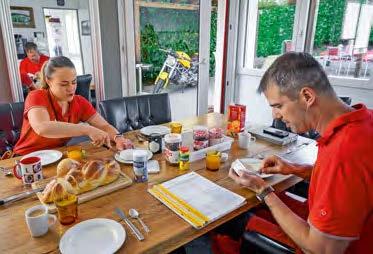

Do we have enough of everything on board? The emergency flight physician checks the medication and replaces anything that is missing. That way she’s always ready to help people in distress. Briefing
Early in the morning, the crew meet for a briefing. The pilot says that the flying weather is good and asks if everyone feels fit and well. There’s bread and coffee for breakfast.
7:00 theTherecreationroomfor Regacrewishere notteBuona
Check the medication EMERGENCY! Mission for the Rega crew Wow, they’re real all-rounders!
10:49 9:00
What’s
weather
18
the
like? Cabin ready? We’re taking off.
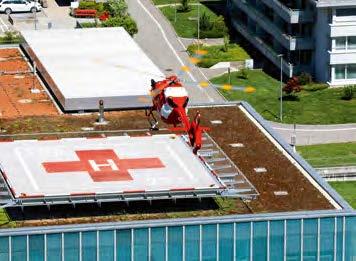


The crew take the patient to the emergency room and hand her over to the hospital doctors and nursing staff. A few days later, she can go home again. That
a busy
Many people needed Rega’s help. But now it’s time for dinner. Perhaps the crew will have to help someone else during the night. In that case, it’s good not to be hungry. A
Lights out – good night! 23:00 Buna notg Bonne nuit Gute Nacht Good night Yum,yum!!
The refuellinghelicopterstation is here 14:14 19:00 EMERGENCY! Eat dinner Everything ok with the helicopter! 19
was
day.
man has severe chest pains. He needs to be flown to hospital quickly. Landing on the hospital roof
12:11
Is it possible to fly in a Rega helicopter without having had an accident?
Elia Bättig (5), 6234 Triengen
No, that’s not possible. If you would like to see a Rega helicopter up close, visit us at an Open Day or a location on our Rega Tour. Your parents can find out when these take place here: regaclub.ch/events
Marco Walker, paramedic, Rega base Erstfeld
How long does it take for the emergency doctor to arrive?
Dominik Bullinger, St. Gallen
The helicopter crew is always made up of a pilot, a paramedic and an emergency flight physician. When an alarm call comes in at the base, the crew are in the air within five minutes and fly to the incident scene as quickly as possible.
Patrick Micallef, emergency flight physician, Rega base St. Gallen
How do I become a helicopter pilot?
Louis Favre (9), Chessel
First you need a licence as a professional helicopter pilot. That’s like a driving licence for helicopters. If you want to work at Rega, you also need to have flown at least 2,000 hours in a helicopter and completed other tasks, such as landing in the mountains and performing flights at night. Experience in carrying out transport flights is also very useful.

Do you also have any questions for Rega? Then send them to us. You can find out how to do this here: regaclub.ch/ your-questions

 Jonathan Volorio, pilot, Rega base Sion
Jonathan Volorio, pilot, Rega base Sion
20

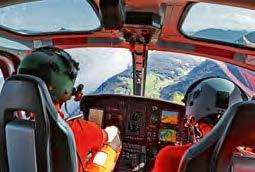
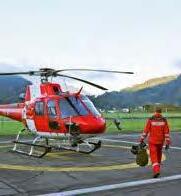






1 2 3 4 5 6 7 8 9 EMERGENCY! BELLA NEEDS HELP! DON’T BE AFRAID, BELLA! WE’RE RESCUING YOU! Quiet, Bella – I’m strapping you in. We’ll soon get you out of here. Have we got enough fuel? Better take extra to be on the safe side! Great that everything went so well. I’m always pleased when we can help an animal in distress. We’ll be there in a few minutes. Hopefully Bella is OK.
now.
Dani, we have a mission for your crew. Oh, a cow has got stranded? We’ll take off right away! 21
Hallo Operations Center! We’ve taken Bella back to the pasture. We’re flying back to the base
My first helicopter flight! There’s a great view from up here!
ButtonsSonstigeCharacters
Look closely! Which of the pictures in the circles below does not appear on the Swiss map? Write down the letter in the solution field.
ABCD
Solution:
Competition
Write the solution together with your name and address on a postcard and send it by 31 July 2024 to:
Swiss Air-Rescue Rega
“Competition RegaCLUB” PO Box 1414
CH-8058 Zurich Airport
Ten winners drawn from the correct answers will each receive a Rega purse worth CHF 35.–. Good luck!
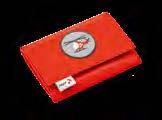
Solution from issue no. 101: 4 and 5
Each of the following has won a Rega school pencil case: R.Müller, Aigle | F. Mäusli, Sierre | N. Clerc, Onnens VD | P. Schlunegger, Klosters | T. Schlunegger, Klosters | L. Strübi, Zurich | V. Trottmann, Winterthur | A. Braun, LützelflühGoldbach | O. Mauri Brusa, Canobbio | E. Garzoni, Novazzano Congratulations!
Publication information
Issue no. 2 | June 2024
Swiss Air-Rescue Rega RegaCLUB PO Box 1414
CH-8058 Zurich Airport
regaclub.ch
Pins Fluggeräte Landschaft
Hügel
Rega erleben Rega Wissen Rätsel und Spiele Filme und Fotos Malen und Basteln
Text-Panel
E HAVE A GO!
22
“Sometimes we have to improvise.”
Sarah Freiburghaus 38, intensive care flight nurse
Usually, Sarah Freiburghaus does not find out until the evening before which country her next mission will take her to and how long she will be away. One thing she likes about her job is that during repatriations from abroad she sometimes encounters unexpected situations.
No mission can be planned down to the very last detail. For Sarah Freiburghaus, this is one of the reasons why she enjoys her job as an intensive care flight nurse at Rega so much. With all jet missions, it is important to constantly consider all the possible scenarios, she says –even before the ambulance jet takes off. Such as when she is preparing the medical supplies and equipment at the Rega Center for a forthcoming repatriation, for example. The medical dossier on the patients that the medical consultants at the Operations Center have prepared during the preliminary clarifications helps her with this. “Our flight coordinators and medical consultants do an excellent job leading up to a mission,” she says. “Nevertheless, as crew members, on location we sometimes have to improvise in order to find the best possible solutions for our patients.”

For example, if a patient’s condition suddenly deteriorates during the flight. Moments like these put the skills of the medical crew in the ambulance jet to the test: “In the air, the flight physician and I are left to our own devices,” explains the flight nurse. As a result, her many years of working in various intensive care units have proved invaluable in her everyday life at Rega. “Experience is a great help when it comes to reacting correctly in unforeseen situations,” she says. Sarah Freiburghaus, who trained as an intensive care specialist after completing her nursing training, continues to work part-time at the University Hospital Zurich. The medical care of patients is one element
of her responsibilities. Another is providing care at a human level. “Patients and their relatives find themselves in an exceptional situation. It is therefore essential that we also support them on a psychological level and are there for them,” she explains. Whether on a medical or interpersonal level, Sarah Freiburghaus enjoys working with patients and their relatives. In most cases, she leaves the hangar at the Rega Center after a mission with a good feeling: “The knowledge that we were able to fly someone home safely after a terrible experience is really rewarding.”
Mathias Gehrig
24h Rega 23
07:15
3 Well prepared: Sarah Freiburghaus compiles the necessary medical supplies and equipment for the mission.


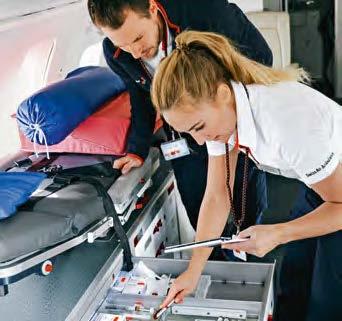

08:00
1 At the briefing, she discusses the mission with the flight coordinator, the cockpit crew and the flight physician. They talk about the medical condition of the patient, as well as the organisational procedure.
08:20
7 Final preparations: in the ambulance jet, Sarah Freiburghaus checks whether all the medicaments and medical supplies for the mission are on board.
24

11:45
1 Everything is going to plan: the patient has been driven directly onto the tarmac at the airport by the local ambulance service. Sarah Freiburghaus helps to load the stretcher trolley into the Rega jet.
14:40
3 During the flight back to Switzerland, Sarah Freiburghaus, together with the flight physician, monitors the patient’s condition.
17:30
3 In her leisure time, Sarah Freiburghaus likes to relax on the farm.
“In the air, the flight physician and I are left to our own devices.”


Video portrait rega.ch/video

25
When horse
power runs wild
Two people pursue their favourite pastime on holiday: on horseback through the Moroccan countryside or on a motorbike on the race track in Spain. But both of these enjoyable activities came to an abrupt end after an accident. Time to call Rega.

Mission abroad
26
Al Massira Airport in Agadir, Morocco: the Rega jet is waiting on the airfield for the patient, the cabin doors open, the ramp unfolded. The sun is shining into the cockpit and the two pilots, Raphael Jenni and Marco Merz, are bent over their tablets. They are preparing for the next leg of the flight – they will be travelling on to Murcia in Spain, where a second patient needs to be collected.
Outside, a member of staff from the Moroccan airport attracts the Rega crew’s attention: the ambulance with the injured Swiss woman is arriving. Intensive care flight nurse Andrea Spindler and flight physician Marcel von Dach climb into the vehicle to greet the patient, Anita Jeg gli. Tears of relief roll down her face.
Carrying a spanner with her
Together with the Moroccan medical staff, the Rega crew carefully push Anita Jeggli up the ramp into the cabin and gently transfer her to the bed in the jet, keeping a constant eye on the patient’s injured leg. Before takeoff, the flight physician examines it more closely. His Moroccan colleagues have attached an external fixation device to the lower leg, as is customary in the initial treatment of such fractures. “It looks clean and very good,” is his verdict. “The good news is that it will heal.” Anita Jeggli breathes another sigh of relief.
The patient asks Andrea Spindler to pass her bag. She removes something and holds it out to the two crew members: “The spanner for the device on my leg!”, she explains. Marcel von Dach gives a grin. It has never happened to him before that a patient is carrying a tool for

Before takeoff, intensive care flight nurse Andrea Spindler makes sure Anita Jeggli is comfortable.
their external fixator with them. “We won’t adjust anything at first,” he assures her. “We want to leave the dressing closed to avoid the risk of infection.” Andrea Spindler attends to the patient, covers her with a blanket, holds the straw in the water bottle to her mouth, checks the drip with the painkillers and the oxygen saturation, and asks if she needs anything else before they take off. Anita Jeggli says no and closes her eyes.
A
second patient is waiting in Spain
Memories of her holiday: Anita Jeggli shows the Rega crew pictures of her horse trekking trip in Morocco.
In the cockpit, pilot Raphael Jenni is on the phone to the flight coordinator at the Rega Center. The crosswind in Murcia could be so strong that the Rega jet has difficulty landing or might even have to fly to another airport. But then the ground ambulance with the second patient in Murcia would be waiting in the
27
Flight physician Marcel von Dach studies the X-ray image of the fractured lower leg.
wrong place. “That’s why we’ll play it safe and fly directly to Alicante,” explains First Officer Marco Merz. Last-minute changes to plans are normal on such missions: the flight coordinator in Zurich will inform the Spanish ambulance and reroute it. During the flight to Alicante, Marcel von Dach holds Anita Jeggli’s X-ray image s up to the light and studies the report from the Moroccan clinic. He records his medical assessment and the painkillers administered in the flight report.
The accident
Later, Anita Jeggli is able to relate what happened: “I’m a passionate horsewoman and
Emergency abroad
Call us on emergency number
+41 333 333 333 if you have a medical problem abroad. Travellers suffering from illnesses or injuries can contact Rega’s medical consultants by phone at any time of the day or night. They give medical advice, provide addresses of local clinics and hospitals, or help to translate and explain medical diagnoses.
No emergency assistance
However, Rega does not provide emergency assistance abroad. Therefore, in the event of an accident or serious illness, you should first call out the local rescue services or contact the nearest doctor or hospital. Only then should you call Rega – for example, to help arrange for you to be admitted to a local hospital or organise repatriation back home to Switzerland.
3 Further information: rega.ch/repat

have often been horseback trekking in Morocco. Every time, riding in a group through the beautiful landscapes is a fabulous experience,” she enthuses. But on the third day of the trek, it happens: during a gallop across the open terrain, a horse next to Anita Jeggli kicks out to the side and hits her lower leg with its hoof. She hears a crack, cries out, and her horse is startled. Although she falls off the horse, in pain and fright she does not let go of the reins. The horse turns around her and stands with its hoof on the same place on her leg. After Anita Jeggli regains consciousness, she looks down: the lower part of her leg is sticking out at an unnatural angle and blood is seeping through her clothing. “Fortunately, residents in the nearby village realised that something had happened and called an ambulance,” she explains. Anita Jeggli is taken to the clinic in Tiznit, 100 kilometres south of Agadir, an hour’s drive away. There she is quickly treated and given painkillers, antisep tic and a diagnosis: an open fracture of her lower leg.
Contact with Rega
Anita Jeggli calls the Rega Operations Center. With the help of the trekking guide and following a telephone conversation, the Moroccan hospital staff send the X-ray images to Rega’s medical consultant. She recommends under-
28

going emergency surgery on location to set and stabilise the fracture. For organising the transport to Switzerland will take some time: the necessary overflight and landing permits have to be obtained, the flight route planned and the local ambulance organised.
Growing concern
A few hours later, Anita Jeggli is operated on and the external fixator is attached and secured to the bones with screws. This stabilises the bone fragments caused by the fracture so that they cannot become misaligned. “I was in very good hands and received professional medical care,” says Anita Jeggli. But she is worried: will her leg make a full recovery? Was everything sufficiently germ-free so that an inflammation would not suddenly develop? These are just some of the questions that bother her. “When I was moved, I was suddenly surrounded by ten people – and then not a soul around.” Anita Jeggli is alone and completely immobile. “I would have liked to have brushed my teeth or washed myself,” she says. But her requests for help go unanswered. It is only later that she realises that the nursing staff at the Moroccan hospital are not responsible for patients’ personal hygiene or meals – the patients’ relatives take care of that. Her trekking guide finally brings her a basin and a facecloth and towel so
that she can wash herself as best she can. “I’m just so grateful we have Rega. I don’t know how I would have got home otherwise,” she says.
Return home in an ambulance jet, not a car
The ambulance jet lands in Alicante to fetch the second patient. After his motorbike accident, Nicolas Schmassmann spent a week in hospital and was planning to drive home by car with his son. Now the Rega patron is lying on the second bed in the ambulance jet and is glad that he is travelling home by jet and not by car. He brushes aside the memory of the accident with a wave of his hand. He is an optimist: “Everything will turn out okay.”
Nicolas Schmassmann had spent his vacation riding his motorbike on the Circuito de Cartagena, near Murcia. On one circuit, his bike skidded from under him on a bend and caught fire. But luck was on his side: no burns, but in hospital the Spanish doctors diagnosed a thoracic trauma and a fractured pelvis and arm. Back home, his wife contacts Rega. In hospital, Nicolas Schmassmann struggles to communicate, even though he speaks Spanish. The Rega medical consultants come to his assistance and provide him with the necessary information about his X-rays and the MRI findings. They advise him against travelling home by car.
From the jet straight to the hospital
After an approximately two hour flight, the Rega jet touches down in Kloten. An ambulance takes the patients to a hospital near their respective homes. This is followed by further medical examinations, a second operation for Anita Jeggli, and days of further recovery – but now in familiar surroundings with family and friends close by.
Corina Zellweger
29
“Rega helps all over the world.”
 Daniel Landert Head of Jet Operations and member of the Management Board
Daniel Landert Head of Jet Operations and member of the Management Board
30
Daniel Landert is responsible for the assistance provided by Rega abroad, and as a pilot also regularly flies missions with the ambulance jet himself.
What does your area of responsibility encompass?
I am responsible for the entire sphere of repatriation – or in a nutshell, for the assistance Rega provides abroad. We employ around 100 staff for this. They include pilots, medical consultants, intensive care flight nurses, flight physicians and flight coordinators, as well as people involved in ground operations, jet maintenance and pilot training.
What fascinates you most about your job?
I love the mix of different tasks, of both operational and strategic issues. In the hangar are our three ambulance jets, which we use to fly ill and injured people home. Within the Management Board, we discuss Rega’s strategy. My work therefore calls for both operational and management expertise. We are a small organisation, and it takes teamwork to be able to help people in distress.
Where in the world can Rega be found?
Rega helps wherever it is needed.
Ever y year, we fly to 400 different airports and airfields around the globe and land in such places as Italy, Morocco, Greenland and New Zealand, but also French Polynesia or Easter Island.
Are there any destinations that Rega does not fly to?
We do not fly to active war zones and only to crisis regions after in-depth clarifications. Nevertheless, despite this we still do our best to help – for example, by organising an ambulance to take the patient to a nearby location where we are granted permission to land.
What does Rega’s assistance abroad involve?
It is very varied. In the event of a medical emergency abroad, our patrons can call Rega around the clock on our emergency number +41 333 333 333. The Rega medical consultants help them over the phone or arrange for them to be transported home. Depending on the patient’s condition, this can be in one of our ambulance jets or on
bo ard a scheduled aircraft. In the latter case, too, the patient is accompanied during the flight by a member of our medical staff.
How complex is it to organise a mission abroad?
It requires the support of various specialists: in the Operations Center, the flight coordinators, medical consultants and flight dispatchers. Then, of course, the flying crews, comprising pilots, intensive care flight nurses and flight physicians. And on the ground, our aircraft mechanics and medical logisticians. We rely on help from our partners abroad, too – for instance, the ambulance vehicles or the handling agents who refuel our aircraft and handle them when they are on the ground. All this has to be organised and coordinated.
How long would it take for Rega to bring me back to Switzerland?
That depends on where you are. In some countries, for example, it takes two or three days before we receive the overflight and landing authorisation. On top of that, we have to determine the best time for the return flight from a me dical point of view. To do this, we talk to the hospital doctors on location. We do all this quickly and efficiently, but it still takes a certain amount of time to ensure that the patient can be repatriated safe and sound. Therefore, if in doubt, it is better to call Rega sooner rather than later.
Karin Zahner
Dialogue 31

Swimming safely in open water
Do you like to cool down in the lake or river in hot weather? Find out how to prevent swimming accidents in open water.
On hot summer days, for many people a dip in the cool water of rivers or lakes provides welcome refreshment. But this is not without risk. According to the Swiss Council for Accident Prevention (bfu), in Switzerland around 12,000 accidents occur every year when bathing and swimming, resulting in an average of 31 fatalities. Most accidents happen in open waters such as lakes and rivers. When it comes to water sports, the greatest danger is drowning. But jumping into unknown, murky water can also lead to serious injury. Particularly with drowning accidents, every minute counts and Rega’s help is in demand: last year, the helicop -
ter crews went into action on around 50 occasions after drowning and swimming accidents. In addition, a Rega helicopter was called out more than 30 times to search from the air for missing persons in the water.
To ensure that you can enjoy your dip or swim to the full, the Swiss life-saving society, Schweizerische Lebensrettungs-Gesellschaft (SLRG), recommends that you prepare well for the forthcoming bathing season and study the recommendations of the local water-rescue or life-saving organisations before your trip to a lake, a river, or the sea. On the next page, you can find the SLRG’s swimming rules of conduct (see box). Many people may be familiar with them, but it nevertheless does no harm to read them again before the start of the season. If you use your common sense, listen to your body and do not overestimate your abilities, nothing stands in the way of your time on, in and around the water being a safe and enjoyable experience.
Knowledge
32

Did you know? Rega originated from the SLRG
On 27 April 1952, members of the SLRG convened at Lake Biel for their meeting of delegates. The physician, Dr Rudolf Bucher, who had shaped the development of the SLRG over more than 20 years, advocated the formation of an ‘offshoot’ of the SLRG that would specialise entirely in air rescue. The meeting approved the motion and Swiss Air-Rescue (SRFW) was founded. Switzerland was thus one of the first countries to operate an organised air rescue service. Initially, the SRFW was a section of the SLRG. On 19 March 1960, with the help of Fritz Bühler, the Technical Director at the time, Swiss Air-Rescue broke away from the SLRG and was completely reorganised.

Question time Marc Audeoud, rescue specialist at the SLRG
Someone gets into trouble in a river or lake. How do I react correctly?
Raise the alarm immediately so that professional help arrives on the scene quickly. You can then try to calm the person down and give them instructions to guide them to the shore. If flotation devices such as lifebuoys, Baywatch buoys or similar are within reach, throw them to the person in difficulty. Another possibility is to hold out a branch or throw a rope for them to catch on to. In this way, you can pull the person ashore without having to get into the water. Only if these options are not possible and you feel confident should you go into the water yourself to rescue the person. For by doing so, you can put yourself in danger too.
The 6 swimming safety rules
The SLRG’s 6 swimming safety rules tell you how to behave by, in and on the water safely:
1 Only allow children near water if supervised –young children should be kept within arm’s reach!
2 Never go into the water if you are under the influence of alcohol or drugs! Never swim with a full or very empty stomach!
3 Never jump into the water if you are overheated! Your body needs time to adjust.
4 Do not dive into cloudy or unknown areas of water! The unknown can be dangerous.
5 Airbeds and swimming aids should not be used in deep water! They do not offer any protection.
6 Never swim long distances alone! Even the best swimmer can experience an attack of weakness.
Why is it dangerous to go into the water myself to help someone?
In a river, there are various potential hazards such as driftwood or obstacles such as bridge pillars. Drowning people also tend to flail their arms around or cling to the rescuer, which can be dangerous for both of them. As a rescuer, always take a flotation device with you that the person in distress can hold onto, and use it to pull them ashore. Situations such as these are discussed and practised in SLRG courses.
What do I have to watch out for when I go swimming in a lake or river?
First and foremost: never go into unsupervised water alone. You should also always have a safe flotation device with you, which can provide valuable assistance in an emergency or if you get tired. Familiarise yourself with the stretch of water beforehand, identify possible hazards, reconnoitre entry and exit points, and if in doubt, don’t go out.
Corina Zellweger
33
Rega Shop

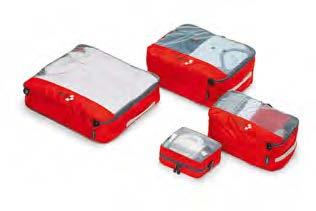


Capcool 39.–
Thanks to its functional textile properties, this intelligent cap with 100 % UV protection has a cooling effect and prevents the build-up of heat. The top-quality fabric is made in Switzerland. Black with reflective elements. Capcool is recommended as head protection by dermatologists. Material: 92 % polyamide, 8 % elastane.
1 Article no. 30050
Exped organiser set 69.–
Four practical pouches from the Exped brand in different sizes, made from air-permeable mesh fabric, keep your luggage well organised. Material: polyester.
2 Article no. 90097
New Exped daypack 99.–
Waterproof, lightweight and durable backpack with roll-top closure from Exped. Ideal for short hikes, bike tours or a stroll through the city. Black. Material: recycled nylon (lining fabric recycled polyester), Oeko-Tex 100. Volume: 15 litres.
Dimensions: 42 × 20 × 15 cm.
3 Article no. 90098
Cap “Aviator” 29.–
Stylish trucker cap with small images of the Rega fleet printed on the front panel. Back with mesh/net insert and adjustable plastic snap fastener. Black & white. Material: polyester.
4 Article no. 30066
New Bestseller Bestseller
Marketplace Order quickly and easily online in our webshop: rega.ch/shop 34





Sunglasses 119.–
CE-certified sports sunglasses with shatterproof, polarised lenses. Black high-tech frame made from highgrade material, flexible yet stable. 100 % UV protection up to 400 nm.
5 Article no. 90087
New AgustaWestland Da Vinci 35.–
Rega’s Da Vinci rescue helicopter as a collector’s model to a scale of 1:48, 24 cm, metal. Not suitable as a toy.
6 Article no. 50027
Challenger 650 29.–
Rega’s Challenger 650 ambulance jet as a collector’s model to a scale of 1:100, 21 cm, plastic (ABS). Not suitable as a toy.
7 Article no. 50020
Airbus Helicopters H145 35.–
Rega’s H145 D3 rescue helicopter as a collector’s model to a scale of 1:48, 28 cm, metal. Not suitable as a toy.
8 Article no. 50026
Outdoor first aid kit 89.–
The most important first aid items for outdoor use, compiled by Rega doctors. This set comprises top-quality material from IVF Hartmann and contains more than 35 products.
External dimensions case: 20 × 13 × 10 cm.
Weight: 600 g.
9 Article no. 90080


Pocket hiking umbrella 49.–
This robust, lightweight pocket umbrella made from state-of-the-art materials has a long lifespan. With automatic opening and closing. Red, with safety reflectors. Dimensions: diameter 98 cm (closed 29 cm).
10 Article no. 90095
New Bestseller
Classic


Online shop
Place your order in comfort and around the clock online via the Rega Shop.
rega.ch/shop
Order by telephone
We would also be pleased to accept your order direct via the following Rega Shop number.
Order telephone: 0848 514 514
New Beach towel, Rega jet 29.–
Beach towel featuring Rega’s Challenger 650 ambulance jet. Material: 50 % cotton, 50 % polyester.
Dimensions: 70 × 140 cm.
11 Article no. 30062
New
Children’s backpack 59.–
Small daypack from the Mammut brand for children aged 6 – 9 years. Comes with a mini helicopter soft toy and a reflective helicopter patch. Volume: 16 litres. Material: polyester.
Dimensions: 38 × 33 × 22 cm.
12 Article no. 40060
Terms and Conditions
Articles are available as long as stocks last. A charge of CHF 8.80 is made per order to cover postage and packaging costs within Switzerland. Articles can be returned within 7 days.
The articles sold in the Rega Shop are of high quality and have been specially selected for our patrons. With your purchase, you are helping Rega to transport emergency medical assistance by air to people in distress 365 days a year.
You can order Rega Shop articles through our online shop at www.rega.ch/shop or by completing the order form and sending it in a stamped envelope to: Rega Shop, Bolligenstrasse 82, CH-3006 Bern.
Sender (please complete in block letters)
Ms Mr unspecified
Family name
First name
Street/No.
Postcode/ Town
Phone no.
Patronage no.
Signature
Thank you for your order.
ENJOY THE SUMMER WITH US!

Teddy bear 35.–
The enterprising Rega teddy bear loves going on discovery trips with young pilots. With his removable helmet and work gear, he is wellequipped to take every adventure in his stride and is never too tired to play. 30 cm high.
13 Article no. 40037



Purse 35.–
Child’s purse with compartments for cards, ID and loose change. Velcro closure. Made from tarpaulin by people with disabilities at a Swiss institution.
14 Article no. 40057
Pencil case 35.–


Order form
There is plenty of room for your coloured pencils in this pencil case. Made from tarpaulin by people with disabilities at a Swiss institution.
15 Article no. 40058
New Rega socks 15.–
Colourful children’s socks from the DillySocks brand in the Rega design, Oeko-Tex 100. Sizes 4–6 & 7–9 years. Cannot be returned or exchanged.
16 Article no. 40066, 40067
wow. mega!
New Art. no. Article CHF Amount 1 30050 Capcool 39.— 2 90097Exped organiser set 69.— 3 90098Exped daypack 99.— 4 30066Cap “Aviator”, black & white29.— 5 90087Sunglasses119.— 6 50027AgustaWestland Da Vinci35.— 7 50020 Challenger 65029.— 8 50026Airbus Helicopters H145 35.— 9 90080 Outdoor first aid kit 89.— 10 90095 Pocket hiking umbrella49.— Art. no. Article CHF Amount
the youngest
11 30062Beach towel,
jet 29.— 12 40060 Children’s backpack 59.— 13 40037Teddy bear35.— 14 40057Purse35.— 15 40058 Pencil case 35.— 16 40066 Socks, size 4 – 6 years 15.— 40067Socks, size 7 – 9
our
rega.ch/shop
Please write your name and address clearly on the front of this card, detach and send in a stamped envelope. Goods are shipped within Europe only. A charge of CHF 45.00 will be made per order to cover postage and packaging costs.
For
Rega fans
Rega
years15.— Order quickly and easily online in
webshop:
Take part and win!
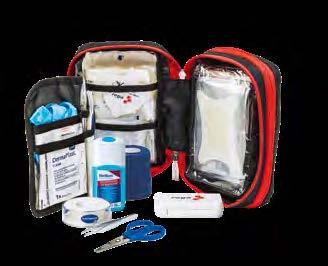
Your opinion is important to us
With the Rega magazine, 1414, we inform you twice a year about news and projects relating to Rega and give you an insight into our work. We are interested in your opinion of the magazine. What do you like about it and what do you think is missing?
To take par t, simply scan the above QR code or click on the link below. The survey takes around five minutes to complete and can be submitted by 30 July 2024 at the latest. In a prize draw exclusively for survey participants, we are giving away 20 outdoor first aid kits from the Rega Shop. Many thanks for taking part and the best of luck!
3 We look forward to receiving your feedback: intervista.ch/rega Take part in our survey and win one of 20 outdoor first aid kits each worth CHF 89.–.
Emergency numbers Switzerland 1414 Abroad +41 333 333 333 Contact Center Changes to patronage rega.ch/login Tel. Switzerland 0844 834 844 Tel. international +41 44 654 32 22 Monday – Friday 8.00 am – 5.00 pm Rega newsletter rega.ch/newsletter Rega Shop Website rega.ch/shop Tel. Switzerland 0848 514 514 Tel. international +41 848 514 514 General information Website rega.ch Rega, PO Box 1414, 8058 Zurich Airport


 David Müller Editor-in-Chief
David Müller Editor-in-Chief





























 Jonathan Volorio, pilot, Rega base Sion
Jonathan Volorio, pilot, Rega base Sion






















 Daniel Landert Head of Jet Operations and member of the Management Board
Daniel Landert Head of Jet Operations and member of the Management Board





















